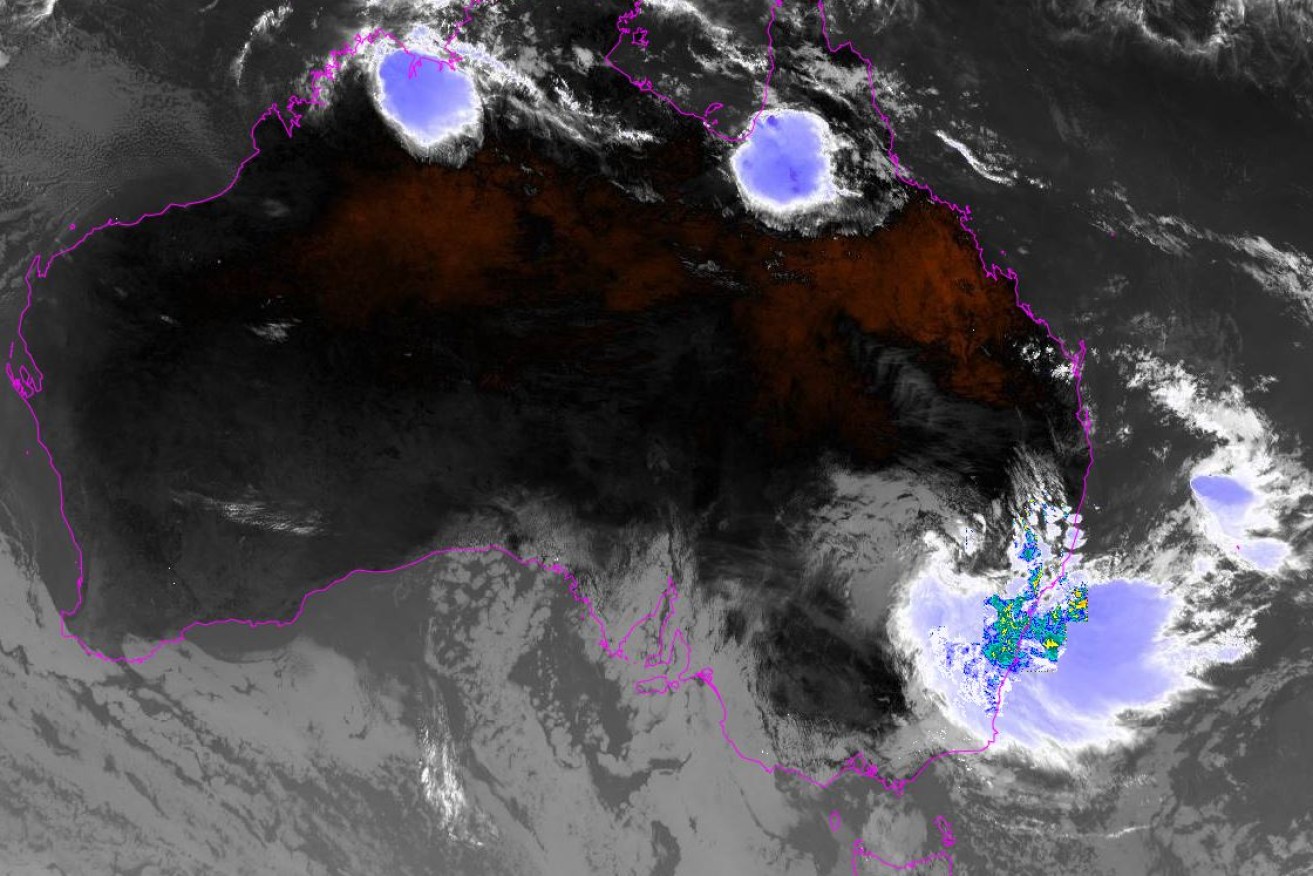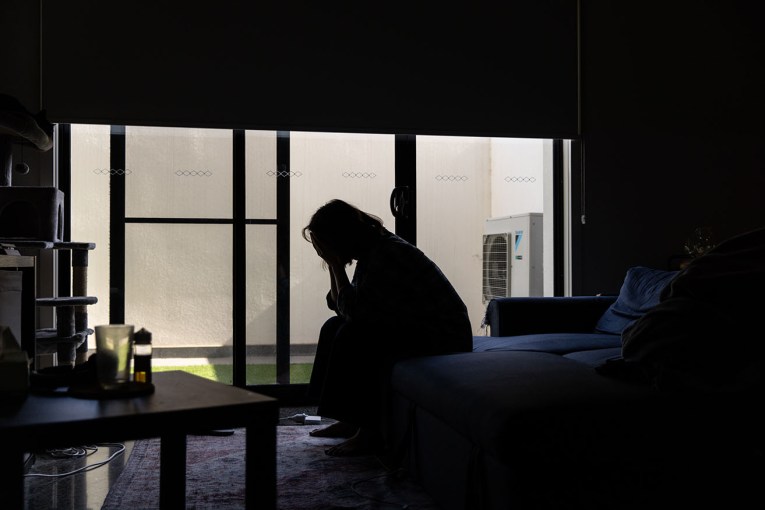Fires and floods: Fatal weather punishes Australian states


The weather map over Australia on Wednesday. Photo: Bureau of Meteorology
Extreme weather is lashing the country, as the eastern states faced some of the most disastrous conditions seen in decades on Wednesday.
Queensland’s raging bushfires have been declared catastrophic and thousands of residents have been ordered to evacuate, as authorities warn the conditions could cause fatalities.
In and around Sydney, three people are dead as the NSW capital experienced its heaviest one-day rainfall in more than 30 years.
Those living and working in the greater Sydney area were urged to avoid unnecessary road travel as the deluge worsened in the lead up to commuter hour on Wednesday afternoon.
Wednesday’s weather conditions are the latest in extremes that have hit the country.
Last week, Adelaide and South Australia were battered by 100km/h winds that left 40,000 properties without power, and several more severely damaged.
As summer officially begins on Saturday, the Bureau of Meteorology is forecasting snow to welcome Tasmania to the season.
Heavy snow is expected to hit elevated parts of the state on Monday and Tuesday.
Deluge in NSW
Three people are dead, two police officers have been injured and almost 130 flights cancelled after a month’s worth of rain was dumped on Sydney in just two hours.
A series of thunderstorms battered the NSW coast from Newcastle down to Wollongong on Wednesday morning, causing havoc for commuters and emergency services.
A 14-year-old boy, an SES volunteer and a driver dies as a direct result of the extreme weather.
The boy died in a two-vehicle car collision on Sydney’s North Shore, while a man died in single-vehicle crash at South Wentworthville and an SES volunteer died after collapsing while on duty in the Illawarra region.
A probationary constable suffered a suspected broken leg and was taken to hospital in a serious condition. Her partner suffered a possible concussion and minor injuries.
Oh cool #SydneyStorm pic.twitter.com/4SfSldqzHx
— Rae Johnston (@raejohnston) November 27, 2018
NSW Police Assistant Commissioner Michael Corboy had a warning for drivers.
“We are really worried about people trying to cross flooded streets or flooded streams in this weather. (And) we’ve already seen idiotic driving [on Wednesday],” he said.
“It is extremely dangerous practice, particularly in smaller cars and we’ve seen people get washed away and killed before on many occasions both in NSW and throughout Australia.”
More than 118 millimetres fell at Observatory Hill in Sydney’s CBD in the six hours to 11am on Wednesday, easily eclipsing the November average of 83.8mm.
Mosman recorded 123 millimetres of rain, while Chatswood had 119 millimetres, including 66 millimetres in an hour.
Disaster plan in place for Queensland
Thousands of Queenslanders were forced from their homes Wednesday as firefighters battled up to 140 wildfires.
Schools were evacuated with many in the danger zone expected to remain closed on Thursday as fire crews prepare for a possible firestorm.
Premier Annastacia Palaszczuk said Queensland still faced unprecedented conditions and “unchartered waters we have not seen the likes of before”.
A fire at Gracemere, near Rockhampton, and a monster fire near Mackay remain “grave concerns” for firefighters.
Evacuation of Mt Larcom now happening @couriermail pic.twitter.com/WcQkqdWqnD
— Chris Clarke (@chrisclarkenews) November 28, 2018
In Canberra, Prime Minister Scott Morrison announced the Commonwealth disaster assistance plan had been activated to help authorities deal with the bushfire emergency.
It allows the state government to seek federal help and access financial assistance in the days, weeks and months to come.
“The entire country is coming to your aid. The entire country is there to help in this time of great need,” Mr Morrison said.
‘You could burn to death’
Police warned residents of Rules Beach they could “burn to death” when a massive bushfire reached the area.
While more than 1000 people left their homes near the Deepwater fire, south of Agnes Waters on the state’s central coast, others on about 50 local properties had ignored pleas to evacuate, even after police went door to door on Tuesday night.
Among them was macadamia grower Robert Griffith. He told The Courier Mail on Wednesday the fire was just three kilometres from his property.
“The wind is hot and dry. You can smell the fire, you can see the embers flying across and the whole farm is littered with burnt leaves from the past couple of days,” he said.
Mr Griffith said nine staff would stay and fight the approaching blaze. Their families had already left.
“Everyone is pretty tired but we’re a close-knit team, so everyone’s spirits are really high,” he said.
More horrific vision coming in from Deepwater in Central Queensland. These fires are catastrophic. Truly scary. #QLDFires @abcbrisbane pic.twitter.com/y0el1Ounqw
— Allyson Horn (@allysonhorn) November 28, 2018
Some residents were reportedly escaping the area by boat.
Weather links disasters
Even though the two bordering states are experiencing polar weather extremes, the Bureau of Meteorology says there is a link.
The bureau’s Sarah Fitton is an expert in extreme weather, and explained the connection to the ABC.
“The trough that’s moving through Queensland [on Wednesday] and producing quite testing fire conditions is extending down into that low-pressure system that is through NSW, so there is a link between the systems,” she said.
Days on end of high temperatures in Queensland have exacerbated the moist air in NSW.
“When we have that combination, a low surface and also a strong trough in the upper atmosphere, what happens is we can really start to see the low-pressure system at the surface rapidly intensify,” Ms Fitton told the national broadcaster.
“We [also] have a lot of uplift in that atmosphere, which helps water to condense and form clouds and showers and then thunderstorms. So it’s the combination of those two things.”
Fire 🔥 Danger Ratings have reached Catastrophic for the first time in #Queensland due to the combination of a very dry, hot airmass and strong, gusty westerly winds. Follow the advice of @QldFES during these extremely challenging fire weather conditions: https://t.co/rfYMgjkWoL pic.twitter.com/tRqG2VnqYA
— Bureau of Meteorology, Queensland (@BOM_Qld) November 28, 2018








